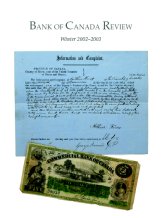Winter 2002-2003

|
Recent Changes to Canada's Financial Sector Legislation by Fred Daniel
Exchange Rate Regimes in Emerging Markets
Transparency and the Response of Interest Rates to the Publication of Macroeconomic Data
See also: Tables A1, A2, and Notes to the Tables |
Cover: A Nineteenth-Century Court Case
Money attracts its share of interest from those eager to make a quick, if dishonest, profit. In the past, scam artists have manufactured counterfeit notes, circulated genuine-looking notes drawn on fictitious banks—even issued large quantities of genuine, non-redeemable notes from institutions under their control. One devious means of defrauding individuals in the nineteenth century was to increase a note's apparent value by changing the numbers indicating its denomination. These doctored notes were said to have been "raised."
The quality of the raised note was sometimes so good that it escaped detection; at other times, as with the note depicted on our cover, the fraud was discovered, with unenviable results for the counterfeiter. The National Currency Collection is fortunate to number among its holdings documents from a nineteenth-century court case in southwestern Ontario that illustrate how some raised notes were offered into circulation as well as the process followed to convict those charged with passing them. The evidence includes a $1 note of the Commercial Bank of Canada raised to a $5 note, the complaint made out against the accused (both shown on the cover), recognizances of two witnesses, the arresting officer's deposition, and the final judgment.
Together, these documents tell the tale of an attempt to pass a raised note at toll booth Number 8 in Hullett Township in December 1862. Boothkeeper Arthur Knox recognized the attempted fraud and brought charges. The local constabulary questioned the accused at a local tavern and searched the stoop, where they uncovered a quantity of questionable notes. Historical records show that at least one of the would-be counterfeiters was arrested and put on trial in April 1863 at the Spring Assizes and found guilty. We have no record of what sentence he received, but equally serious attempts at counterfeiting often drew lengthy sentences of hard labour in one of the province's jails.
The raised note that formed part of the evidence to convict is a genuine note whose centre has been scraped and painted green to remove indications of its true denomination. Large numerals or words called counters have been glued over the original counters in the note's upper right and lower left corners with the deliberate intention of creating a higher-value note. Unfortunately for the accused, however, the design of the two notes was different. A genuine $5 note included vignettes showing a surveyor and a man with a pick and shovel, not the native and young girl pictured on the altered $1 note.
This case serves as a reminder that even today it is important to be well informed and observant with respect to the money that we handle.
The note and court document shown on the cover form part of the National Currency Collection, Bank of Canada.
Photographed by Gord Carter, Ottawa




